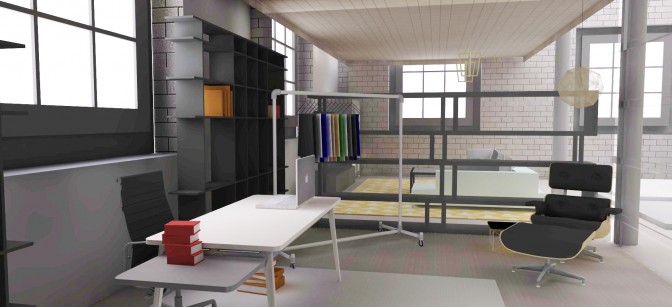This is the fifth of twelve installments in a column, which will explore her experience of combining both worlds that seem so close, yet so far: Interior Architecture and Business. Read the first installment here, second here, third here, and fourth here.—
On the featured image above: Never would I ever thought I can generate such picture from scratch. Not in between my Excel sheets.
—
Two weeks before writing this essay, I have just finished doing one thing that has become an end-of-the-year tradition for college students all over the world: attending friends’ graduation ceremonies. Exactly a year ago I was walking down the hallways of Agganis Arena at Boston University to receive my Bachelor’s Degree, and I find it hard to believe that at this very moment I have finished my first year of graduate school. With two intense studio classes plus a design internship for me to handle over the Summer, I occasionally realize how things can change quickly, yet some remain the same. My life as a design/architecture student brings a new wave of excitement and challenges. Additionally, skills learned as an undergraduate in business school often comes in handy at times.
Here’s my take on what changes and what stays after a year of grad school:
My first year at a Graduate Design school taught me some things when it comes to learning just because you have to or because you want to. Most of my classmates so far have been some of the most determined students I have ever met. We are all gathered at the same space with different backgrounds; let it be a photographer, museum curator, electrical engineer, or operations analyst. Everybody walks into the classroom with their own flair and design sensibility, and our conversations in between class breaks have been nothing but sort of interesting. From our talks I learned about why people decided to make a career change despite their not-so-young age, why are we all driven by the same thinking framework and where do we want to be after we’re done submitting our thesis. In other words, networking has been a tremendously fun part besides all projects and design works that keeps us awake at most nights.
My first year in Graduate Design school taught me a great lesson on building your ‘new resume’ as early as possible. I reminded myself that the return for this educational investment is not simply a diploma, but a clear career path and an extensive professional network for me to utilize in the future. A lot of times I am bogged down by the harsh reality that some Interior Design-related jobs require a set of advanced skills that only second year students have in hand already. How can someone with zero Adobe Revit & 3DSMax skills can actually compete with the more experienced, soon-to-graduate students? For the past year I have been looking for several opportunities that might lead me to a my first foothold in design, and networking seems to be the key. I am glad to have made some braver initiatives with my professors and vendors whom I have contacted for product specifications; I learned that there is no harm in knocking someone else’s door and simply asking whether they need a hand in their office. From there I was able to secure a considerably unique position, which also enables me to continue my education at the same time. Additionally, my current job also comes with several advantages that I believe will help me in completing some of my school projects – from attending free professional seminars, having opportunity to be involved in real-life commercial projects to gaining special access to materials library that are not available on my campus, these are just some of few perks that would not have ever happened if I continue my doubts to linger upon.
My first year at a Graduate Design school also taught me that there is no such thing as ‘things you have learned back in undergrad go into waste.’ At times I found it fascinating how Business and Design often collides, which I am positive I have been confessing this belief multiple times. The most fundamental principles of design has been (or should be) utilized as the framework of a problem solving approach in the business world. Upon designing a space, a lot of things need to be considered prior to coming up with a concept: the users’ needs and perception of certain things, their psychological traits and cultural influences, their intended message on identity and purpose, and to forget their budget constraints and safety considerations. Do all of these necessities sound familiar upon creating a product and trying to selling it towards the public? Going into a design school trains me into an ever better observer, meticulous planner and to be considerate. A lot of times I also find it very challenging to wear a different hat this time and looking things from a designer perspective. Back in my business school years, it was the ‘seller hat’ I was wearing, thus making me only having to care about the finances, marketing, operational, distribution and overall business strategy I have to think about. However, now I got the chance to experience how it feels like behind a product creation process, and that makes me to appreciate each step even more. Having good business knowledge and skills in handy also helps me in understanding what makes a great product or space easily received by the public.
Last but not least, my first year at a Graduate Design school taught me that apparently there are a lot of people around that are as equally capable as you. In the end, you just need to be yourself and show what you are worth. Try smart, work hard, and just go on.
Image above belongs to the author.










[…] Interior Architecture vs. Interior Design: Which Program to Choose? July 16, 2015 · by Alicia Kosasih · in America, By Application Process, By Level of Study, By Region, Career, Choosing Majors, Columns, Graduate, Opinion TweetThis is the sixth of twelve installments in a column, which will explore her experience of combining both worlds that seem so close, yet so far: Interior Architecture and Business. Read the first installment here, second here, third here, fourth here, and fifth here. — […]